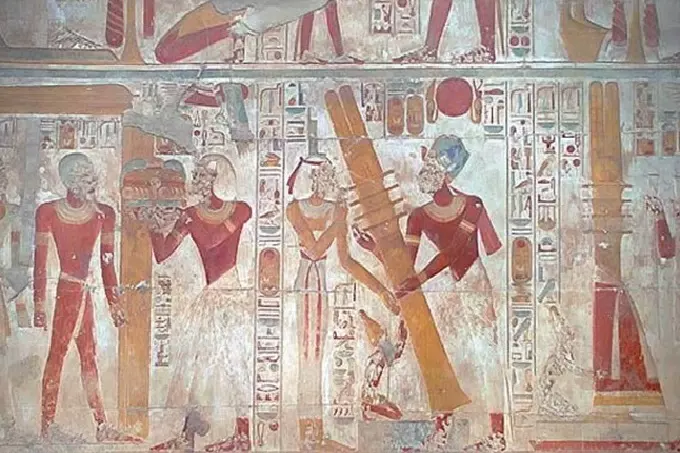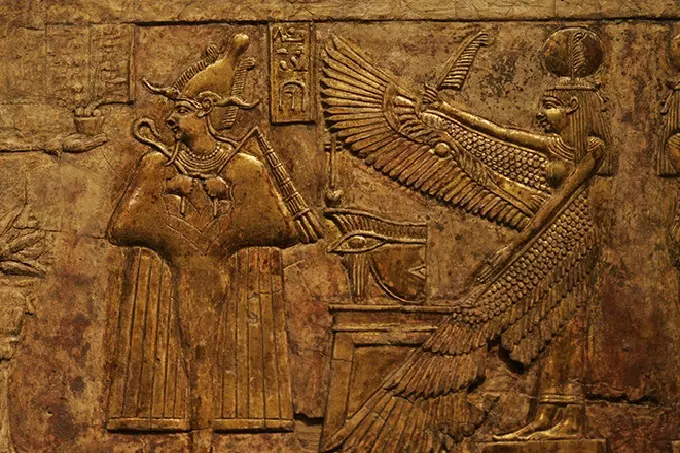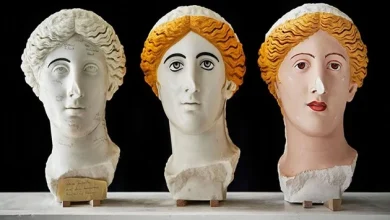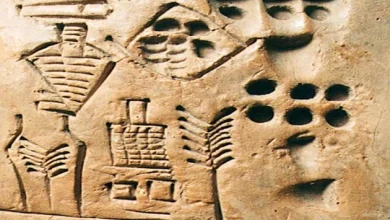How an ordinary painted pillar caused the decline of ancient Egypt?

One of the most advanced and greatest civilizations of antiquity is, of course, the Egyptian. It may seem strange, but in fact, there is much more in common between Ancient Egypt and the modern world than it might seem at first glance.
The most interesting coincidences are found in religious art. By and large, it was here that the first icons were born. The ancient state keeps so many secrets that the entire scientific world for centuries cannot comprehend at least a small part of them. What secret is hidden by the most mysterious and ancient artifact of Egypt, the progenitor of icons?
Ancient artifact mystery
If there was an ancient civilization that used artistic icons, it was Egyptian. The schematic characteristics of the style developed there left to future generations several such as the Ureo (a straight cobra that represented the goddess Wadjet), the Ankh (the cross of eternal life), the Udyat (the Eye of Horus), a protective amulet, and many others. Perhaps the most mysterious and ancient of all is the pillar, made up of overlapping sheaves of wheat. This pillar symbolized stability and was associated with the myth of the resurrection of Osiris. It played a fundamental role in several ritual festivals and was called Djed.
The bond between Jed and Osiris was so intimate that it represented his spine. That is, the most important part of the anatomy then, for he himself ascended to heaven, using the spine of his mother Nut as a ladder. In sarcophagi, under the back of the mummy, an amulet of this form was always placed in order to provide the deceased with stability in eternity.
In addition, Tayet or the Knot of Isis, a symbol of resurrection, was wrapped around the neck so that there was a male and female principle, an allegory of the duality of life. There was a prayer in the Book of the Dead: “Arise, Osiris! You have a basis, even though your heart no longer beats; you have vertebrae, the one whose heart no longer beats. Turn on your side, let me put water under you! I bring you a Painted Pillar of Gold. May you rejoice in it!”
Interestingly, before becoming a symbol of Osiris, this artifact was associated with another ancient god. It was a Memphis deity named Ptah. He carried a scepter that was adorned with an Ankh.

Memphis is the capital of the Old Kingdom. It was once the center of a ceremony in honor of this deity and Sokar, the funerary god in the form of a mummified falcon, representing decadence. The rite consisted of raising the djed, which was supposed to provide the pharaoh with a calm and stable reign. Later, the ritual developed to involve Osiris in the myth. The gods formed a trinity and turned out to be very close to the modern perception of religious worship.
Osiris, pharaoh, and prosperity
The myth of Osiris in ancient Egypt was the most important in Egyptian culture. The promise of an eternal afterlife gave him popularity.
The oldest versions of the myth are found in the Pyramid Texts. It says that the god of death and the ruler of Egypt, Osiris, was treacherously killed by his younger brother Seth. The latter was the lord of chaos and the god of drought. His wife Nephthys cheated on him with Osiris. After the murder, Seth threw the body in a coffin into the waters of the Nile River.
The current carried him to the shores of Lebanon. There, the coffin got stuck in a tree growing nearby and grew into it. After some time, the king of that land ordered the tree to be cut down and placed in his palace, completely unaware of what was inside him.
Meanwhile, Isis, wife of Osiris and sister of Nephthys, desperately searched for her husband with the help of Anubis and finally discovered his whereabouts. She persuaded the king to give her the pillar. Then Isis revived her husband and returned with him to Egypt.
During the New Kingdom, the myth underwent some changes. According to them, Seth brought the sarcophagus, but before that, he scattered his brother’s remains across the Nile Valley. Isis and Nephthys had to collect them before mummifying the body. Osiris and Isis subsequently had a son, Horus. Set cut Osiris exactly into forty-two parts, according to the number of nomes (provinces) of Egypt. Osiris, therefore, came to personify the kingdom.
The oldest symbol
Later, other innovations appeared besides the confluence of Ptah-Sokar-Osiris. The column became anthropomorphic, taking on human features. This is noticeable on the reliefs of the Dendera temple, in the temples of Amenhotep III, the temple of Luxor, or the temples of Mennonius Abydos, the funerary temple of Seti I. There Djed in the form of the resurrected Osiris, adorned with two udyats and wearing various crowns. In the last city, a ritual was performed with Jed at one time. The Egyptians tried to unite Upper and Lower Egypt with this symbol of stability and prosperity. This pillar played a very important role in the great religious holidays. So far, scientists have not been able to accurately recreate its role. One can only guess from some of the pictures.
Various processions followed one after another. The revival ceremonies were conducted personally by the pharaoh. The action ended with the raising of the column, identifying the resurrection of Osiris with the resurrection of the king. The event was crowned by the final launch of arrows to the four cardinal points. This served as a prototype for protecting the borders of the state from enemies.
The pillar was a kind of amulet. He was often depicted in frescoes and reliefs. This symbol is deeply rooted in Egyptian culture. Egyptologists are sure that it is much older than is commonly believed. It is connected, in their opinion, with prehistoric agricultural rites and rituals. This symbol was found on the most ancient artifacts discovered in Egypt.
Some researchers believe that the djed was an object associated with fertility, possibly some kind of totem. After all, his image contains sheaves of cereals or reeds. Others believe that the myth was based on a tree. In the story of Osiris, a coffin containing his body was grown into him. The king of the lands where Phoenicia and Syria were located supplied timber to Egypt. After all, in this country, mostly desert, there are almost no trees.
The tree is precisely the element that connects Jed with the hypothesis put forward a century ago, in 1922. In the same year, the tomb of Tutankhamun was discovered. Djed has certain parallels with Assyrian sacred trees. Assur, the god whom the Assyrians, having reached their imperial climax, turned into the lord of war, was formerly the lord of life. It is associated with the Tree of Life. This concept is common to many religions.

Another recent hypothesis, proposed by Andrew Hunt Gordon and Calvin W. Schwabe, is that the Anj, Uas, and Djed symbols have their origin not so much in the plant world as in the animal world. The Egyptians believed that the seed is formed from the bone marrow. The city of Mendes has its own version of the myth, which says that the spine of Osiris and his phallus were kept here. It was the only body part of Osiris that Isis did not find, and she had to make it out of clay in order to conceive Horus.
Curiously, in Hindu Tantrism, kundalini, the primordial energy from which the consciousness of the world arises, is located in muladhara. This is one of the seven primary chakras, located at the base of the spine, where, according to this philosophy, the cerebrospinal fluid, spinal cord, and sperm are formed. Experts are now debating whether this implies a connection between the two ancient cultures.
How many exciting secrets history has not yet been revealed to mankind.




